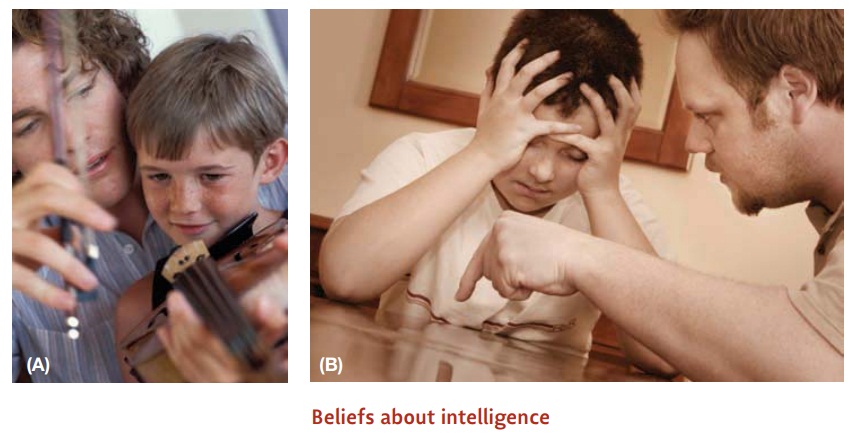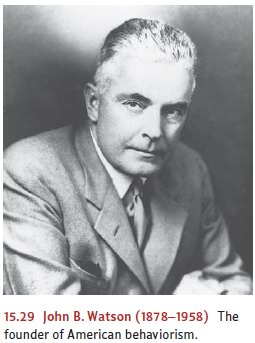Chapter: Psychology: Personality
Origins of the Social-Cognitive Approach

Origins of the Social-Cognitive Approach
Social-cognitive
theories vary in their specifics, but all derive from two long-standing
traditions. The first is the behavioral tradition, set in the vocabulary of
reward, punish-ment, instrumental responses, and observational learning . The second
is the cognitive view, which emphasizes the individual as a thinking being.
BEHAVIORAL ROOTS OF SOCIAL – COGNITIVE THEORIES
Central
to the behavioral tradition is a worldview that, in its extreme form, asserts
that virtually anyone can become anything given proper training. This American
“can-do” view was distilled in a well-known pronouncement by the founder of
American behaviorism, John B. Watson (Figure 15.29):

Give
me a dozen healthy infants, well-formed, and my own specified world to bring them
up in and I’ll guarantee to take any one at random and train him to become any
type of specialist I might select—doctor, lawyer, artist, merchant-chief, and,
yes, even beggar-man and thief, regardless of his talents, penchants,
tendencies, abilities, vocations, and race of his ancestors.
Watson’s
version of behaviorism was relatively primitive, but elements of his view are
still visible in subsequent theorizing within the social-cognitive perspective.
For example, Albert Bandura (like Watson) places a heavy emphasis on the role
of experience and learn-ing, and the potential each of us has for developing in
a variety of ways. But Bandura’s view of personality goes considerably beyond
Watson’s in its emphasis on the role we play as agents in fashioning our own
lives. According to Bandura (2001), we observe relation-ships between certain
actions (whether ours or others’) and their real-world consequences (rewards or
punishments), and from this we develop a set of internalized outcomeexpectations, which then come to
govern our actions.
In
addition, we gradually become aware of ourselves as agents able to produce
cer-tain outcomes, marking the emergence of a sense of self-efficacy, or a belief that one can perform the behaviors that
will lead to particular outcomes (Bandura, 2001, 2006). When a person’s sense
of self-efficacy is high, she believes that she can behave in ways that will
lead to rewarding outcomes. By contrast, when a person’s sense of self-efficacy
is low, she believes herself incapable, and she may not even try. Researchers
have found high self-efficacy beliefs to be associated with better social
relationships, work, and health outcomes (Bandura, 1997; 2001; Maddux, 1995;
Schwarzer, 1992). Likewise, self-efficacy beliefs about a particular task (“I’m
sure I can do this!”) are associated with success in that task. This attitude
leads to more persistence and a greater tolerance of frustration, both of which
contribute to better performance (Schunk, 1984, 1985).
Once
outcome expectations and beliefs about self-efficacy are in place, our actions
depend less on the immediate environment, and more on an internalized system of
self-rewards and self-punishments—our values and moral sensibilities. This
reliance on internal standards makes our behavior more consistent than if we
were guided simply by the exigencies of the moment, and this consistency is
what we know as personality. As seen from this view, personality is not just a
reflection of who the individual is, with a substantial contribution from biology.
Instead, in Bandura’s perspective, personality is a reflection of the
situations the person has been exposed to in the past, and the expectations and
beliefs that have been gleaned from those situations.
COGNITIVE ROOTS OF SOCIAL – COGNITIVE THEORIES
A
related tradition underlying social-cognitive theories of personality is the
cognitive view, first detailed by George Kelly (1955). Like many other
psychologists, Kelly acknowledged that people’s behavior depends heavily on the
situation. Crucially, though, he emphasized that much depends on their interpretations of the situation, which
Kelly called their personal constructs,
or the dimensions they use to organize their experience.
From
Kelly’s perspective, each person seeks to make sense of the world and find
meaning in it. To explain how people do this, Kelly used the metaphor of a
scientist who obtains data about the world and then develops theories to
explain what he has observed. These theories concern specific situations, but,
when taken together, consti-tute each individual’s personal construct system.
To assess these personal constructs, Kelly used the Role Construct Repertory
Test. This test asks people to list three key indi-viduals in their life, and
then to say how two of these three were different from a third. By repeating
this process with different groups of three ideas, traits, or objects, Kelly
was able to elicit the dimensions each person used (such as intelligence,
strength, or goodness) to make sense of the world.
Kelly’s
work is important in its own right, but his influence is especially visible in
the work of his former student, Walter Mischel. For Mischel (whom we met
earlier), the study of personality must consider neither fixed traits nor
static situations, but should focus instead on how people dynamically process
various aspects of their ever-changing world. Like Kelly, Mischel contends that
the qualities that form personality are essentially cognitive: different ways
of seeing the world, thinking about it, and interacting with it, all acquired
over the course of an individual’s life. But how should we conceptualize this
cognition, and, with it, the interaction between the individual and the
setting?
Mischel’s
answer to this broad question is framed in terms of each individual’s
cognitive-affective personality system (CAPS), which consists of five key
qualities on which people can differ. The first is the individual’s encodings, the set of construals by
which the person interprets inner and outer experiences. Second, individuals
develop expectancies and beliefs about
the world, which include the outcome expectations andsense of self-efficacy
stressed by Bandura. Third, people differ in their affects—that is, their emotional responses to situations. Fourth,
they differ in their goals and values,
the set of outcomes that are considered desirable. Finally, CAPS includes the
individual’s competencies and
self-regulatory plans, the way an individual regulates her own behaviorby
various self-imposed goals and strategies (Mischel, 1973, 1984, 2004; Mischel
& Shoda, 1995, 1998, 2000).
Other
researchers have filled in many details about what these various beliefs
involve. For example, Carol Dweck and
her colleagues have argued that people differ in their fundamental assumptions
about their own abilities (Dweck, 1999, 2006; Dweck & Leggett, 1988; Molden
& Dweck, 2006). Some people assume their abilities are relatively fixed and
unlikely to change in the future. In con-trast to this entity view, others hold an incremental
view—assuming their abilities can change and grow in response to new
experience or learning (Figure 15.30). These assumptions turn out to be rather
important, because people with the incremental view are more willing to
confront challenges and better able to bounce back from frustration (Dweck,
2009). Evidence comes from many sources, including studies that have tried to
shift people’s thinking from the entity view to the incremental view. In one
study, Blackwell, Trzesniewski, and Dweck (2007) randomly assigned junior high
school stu-dents either to a regular study skills group or to an experimental
condition that taught students that the brain is like a muscle and can get
stronger with use. Compared to

those
in the study skills group, those in the experimental group showed increased
moti-vation and better grades.
These
differences in belief are another point in which cultures differ. Evidence
sug-gests, for example, that Americans tend toward the entity view, while the
Japanese tend toward an incremental view. This is reflected in the belief among
many students in the United States that the major influence on intelligence is
genetics; Japanese students, in contrast, estimate that the majority of intelligence
is due to one’s efforts (Heine et al., 2001). This result is likely related to
another finding we mentioned earlier: Americans tend to perceive themselves as
consistent in their behaviors as they move from one situation to the next, a
view similar to the entity view of intelligence, which emphasizes the stability
of one’s abilities. Some other cultures put less emphasis on personal
consistency, leaving them ready to embrace the potential for growth and change
at the heart of the incremental view.
Related Topics